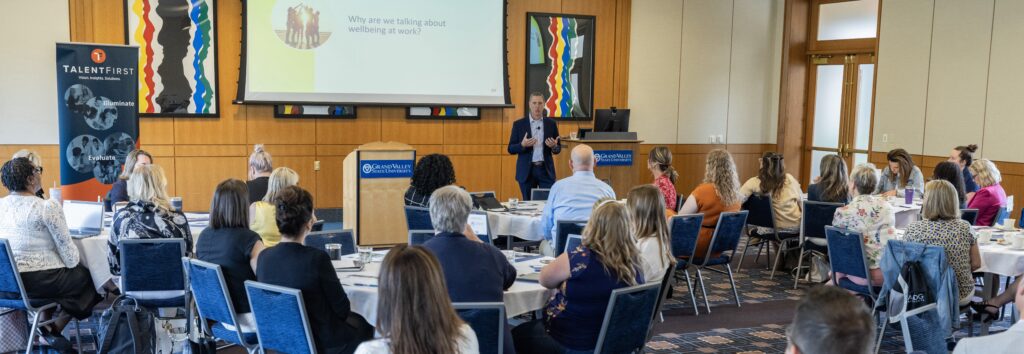In 2018-19, more than 59% of Michigan college graduates left school with student loan debt averaging $30,677. That is the 17th-highest level in the nation.
Knowing that most jobs will require a post-secondary education by 2025, how do students offset that debt burden as they pursue a better life?
One option is to work.
For many post-secondary students, however, employment is far from optional. It is a matter of survival. This raises questions about how working students are supported, including how well education lines up with career pathways.
Putting in hours
A recent report by the Center for Community College Students highlighted the necessity of work for many older adults and low-income students – and not just in picking up a few hours here and there.
Twenty-nine percent of respondents to the Community College Survey of Student Engagement reported working for pay more than 30 hours per week. Many reported working over 40 hours a week, and a small portion reported working at least two jobs to keep up.
Many adults go back to school to gain additional skills in their chosen career pathway, so it is not surprising that 40% percent of respondents older than 30 reported working for pay in their current field of study. For older students and full-time employees, working and being in school were viewed as equally important.
A difficult balancing act
While working to pay for college experience is often viewed as a positive, the survey found some drawbacks:
- More than a third of entering students who work reported that it can be difficult to take classes they need, typically due to scheduling around their work.
- Seventeen percent of entering students reported missing class because of work at least once in the first three weeks of class.
- On top of job responsibilities, 24% of working learners are also raising children.
- Sixty percent of low-income working learners who work more than 15 hours a week on average earn grades of C or lower.
A little under half of today’s working learners are low-income students for whom a job is a necessity, according to the Georgetown University Center on Education and the Workforce.
A 2018 Georgetown report, Balancing Work and Learning: Implications for Low-Income Students, states that, when students try to pay a larger share of college costs from their current earnings, it creates unintended pressure to work longer hours. This can have a negative impact on academic performance and completion.
Helping working learners
Succeeding in the workplace of the future increasingly will require education and training beyond high school. Therefore, it is important for K-12 and post-secondary education to remain aligned in providing workforce opportunities for students and making students aware of the full range of career opportunities available in the region.
K-12 can start by building stronger connections between education and work, starting as early as elementary grades. Secondary and post-secondary institutions can help students make better choices in majors and careers by understanding the labor market outcomes of career-technical education and post-secondary programming, while expanding both the times and modes of delivery for courses and career advising to accommodate those who may be working or otherwise unavailable during traditional hours of operation.
Institutions should consider providing additional online options for students who might be facing transportation or childcare barriers, or those who simply cannot make the commute from work to school in time to make their class or advising appointment. Offering courses and guidance at times and modes that accommodate the hectic schedules of working adults will empower more students to succeed in postsecondary programming. In addition to expanding career counseling and guidance to provide more options at varying times and methods, secondary and post-secondary institutions must offer more robust support services for working learners — with a special emphasis toward meeting the needs of low-income students.
In West Michigan, some of this work has been happening for years.
School districts have added career exploration activities, work-based learning opportunities, job shadowing and online platform career exploration like MAVIN. Community colleges have invested in strategic pathways for students to help with scheduling and advising. Post-secondary institutions have acknowledged the benefit of retaining working learners and understanding the barriers that exist for this population.
Addressing challenges of COVID-19
The pandemic has only emphasized the necessity of post-secondary education, with a disproportionate impact on jobs with less-educated workforces: 4 in 5 lost jobs in the service field and 3 in 5 lost jobs requiring a high school diploma or below.
However, the recession of COVID-19 differed from past recessions in that it did not spur higher education enrollment. In fact, Michigan saw a 9.7% decrease in post-secondary enrollment in the fall of 2020. Even more importantly, 69% of the total drop in the national undergraduate enrollment was among first-time students, with staggering declines in numbers of first-generation, low-income, and non-white students.
In Michigan, the Futures for Frontliners program seeks to offset that trend through state scholarships for residents without college degrees who worked in essential industries during the state COVID-19 shutdown in spring 2020.
An estimated 85,000 people have applied. Many applicants have described the sense of relief to be able to pursue an education without worrying so much about working enough hours or acquiring huge amounts of debt.
“I recently got married and have thought about going back to school to get a degree,” wrote one applicant from Spring Lake. “But with changing jobs and taking a pay cut, it didn’t seem possible. Being able to go to school and not have to worry about making ends meet is an absolute blessing.”
{{cta(‘d60ba4b7-35ab-4063-b38f-075d8956d281′,’justifycenter’)}}


